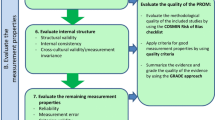Abstract
Purpose: To determine the effect on patient responses from the order in which the generic health-related and vision-targeted instruments are administered in a set of randomized clinical trials of intraocular surgery. Patients and methods: Patients who agreed to enroll in the Submacular Surgery Trials (SST) completed baseline quality of life interviews prior to random assignment to surgery or observation. Interviews were conducted by trained interviewers located at the SST Coordinating Center, via a computer-assisted telephone interview system that randomly assigned the order of instrument administration. Either the generic health-related instruments were administered first, the SF-36 Health Survey (SF-36) followed by the Hospital Anxiety and Depression Scale (HADS), followed by the vision-targeted instruments, National Eye Institute-Vision Function Questionnaire (NEI-VFQ) followed by the SST-Vision Preference Value Scale, or the vision-targeted questions were asked first, followed by the generic health instruments. The four instruments have 25 subscales total. Results: Of the 1015 patients enrolled in the SST, 992 patients had all four instruments administered in random order: 483 (49%) patients responded to the generic instruments first and 509 (51%) patients responded to the vision-targeted instruments first. Order of administration produced significantly different scores for three health status subscales: SF-36 mental health, HADS depression and HADS anxiety (p≤0.05, Wilcoxon rank sum test). Conclusions: Overall, the order of administration did not have a large effect on responses to the baseline interviews in this study. However, three mental health subscales were affected by order, though the order effect was small in magnitude. When the generic health instruments followed the vision-targeted instrument the HADS depression and anxiety scores were higher and the SF-36 mental health scores were lower, both suggesting poorer mental health status. Thus, the order of administration in other settings in which both a generic health-related instrument and a condition-targeted instrument are used may be decided based on individual study goals and priorities but order of administration should be consistent throughout the study.
Similar content being viewed by others
Abbreviations
- HADS:
-
Hospital Anxiety and Depression Scale
- HRQoL:
-
Health-related quality of life
- MCS:
-
Mental Component Summary (from the SF-36)
- MHI-5:
-
Mental health 5-item subscale (from the SF-36)
- NEI-VFQ:
-
National Eye Institute-Vision Function Questionnaire
- PCS:
-
Physical Component Summary (from the SF-36)
- SF-36:
-
SF-36 Health Survey
- SST:
-
Submacular Surgery Trials
- SST-VPVS:
-
Submacular Surgery Trials – Vision Preference Value Scale
References
Drummond MF, ed. Measuring the Quality of Life of People with Visual Impairment. Proceedings of a Workshop. NIH Publication No. 90-3078. Bethesda, MD, U.S. Department of Health and Human Services, Public Health Service, National Institutes of Health, 1990.
CM Mangione RS Phillips JM Seddon MG Lawrence EF Cook R Dailey L Goldman (1992) ArticleTitleDevelopment of the ‘Activities of Daily Vision Scale’: a measure of visual functional status. Med Care 30 1111–1126
GH Guyatt DH Feeney DL Patrick (1993) ArticleTitleMeasuring health-related quality of life. Ann Internal Med 118 622–629
DL Patrick RA Deyo (1989) ArticleTitleGeneric and disease-specific measures in assessing health status and quality of life. Med Care 27 IssueID(3) S217–S232
JE Ware JP Kemp DA Buchner (1998) ArticleTitleSinger AE, Nolop KB and Goss TF. The responsiveness of disease-specific and generic health measures to changes in the severity of asthma among adults. Qual Life Res 7 235–244
AW Wu et al. (1997) ArticleTitleThe effect of mode of administration on Medical Outcomes Study health ratings and EuroQol scores in AIDS. Qual Life Res 6 3–10
MJ Barry et al. (1996) ArticleTitleMeasurement of overall and disease-specific health status: does the order of questionnaires make a difference? J Health Serv Res Policy 1 IssueID(1) 20–27
Submacular Surgery Trials Research Group. Submacular Surgery Trials (SST) Manual of Procedures. NTIS accession no. PB98-166648. Springfield, VA, National Technical Information Services, U.S. Department of Commerce, June 1998.
Ware JE. SF-36 Health Survey Manual and Interpretation Guide. Boston, The Health Institute, New England Medical Center, 1993.
AS Zigmond RP Snaith (1983) ArticleTitleThe Hospital Anxiety and Depression Scale. Acta Psychiatr Scand 67 361–370 Occurrence Handle1:STN:280:BiyB2sbhtVw%3D Occurrence Handle6880820
CM Mangione et al. (1998) ArticleTitlePsychometric properties of the National Eye Institute Visual Function Questionnaire (NEI-VFQ). Arch Ophthalmol 116 1496–1504
Submacular surgery Trials Research Group. Patients perception of the value of current vision: Assessment of preference values among patients with subfoveal chorodial neovascularization. SST Report No. 6. Arch Ophthalamol; (in press).
CM Mangione et al. (2001) ArticleTitleDevelopment of the 25-Item National Eye Institute Visual Function Questionnaire. Arch Ophthalmol 119 1050–1058
JE Ware (1994) SF-36 Physical and Mental Health Summary Scales: A User’s Manual. The Health Institute, New England Medical Center Boston
GW Snedecor WG Cochran (Eds) (1980) Statistical Methods EditionNumber7 Iowa State University Press Ames, Iowa 144–145
JW Tukey (Eds) (1997) Exploratory Data Analysis Addison-Wesley Publishing Company Reading, MA 34–41
DG Froberg RL Kane (1989) ArticleTitleMethodology for Measuring Health-State Preferences–IV: Progress and a Research Agenda. J Clin Epidemiol 42 675–685
Author information
Authors and Affiliations
Corresponding author
Additional information
The Submacular Surgery Trials Research Group - Members of the SST Patient-Centered Outcomes Subcommittee who take responsibility for the content of this report, SST Report No. 3, on behalf of the SST Research Group are listed in Appendix A. The reference for the SST Research Group is in Appendix A.
Rights and permissions
About this article
Cite this article
Childs, A.L. Effect of order of administration of health-related quality of life interview instruments on responses. Qual Life Res 14, 493–500 (2005). https://doi.org/10.1007/s11136-004-0727-9
Accepted:
Issue Date:
DOI: https://doi.org/10.1007/s11136-004-0727-9




